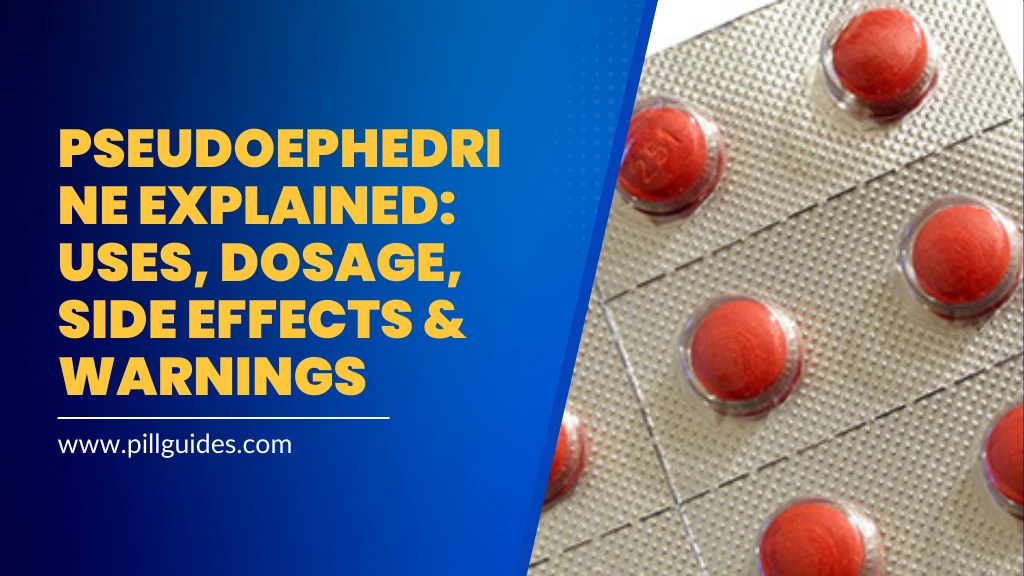Pseudoephedrine is one of the most common over-the-counter decongestants to treat nasal congestion associated with colds, allergies, or sinus infections. This medication works because it shrinks the blood vessels in the nasal passages and helps with swelling and breathing. But just like any other drug, one must know the right use of it, the doses it has, Pseudoephedrine side effects, and its precautions while using it. With this Pseudoephedrine guide, you will be able to correctly take and use it for the benefit of your health, while avoiding disastrous side effects.
What is Pseudoephedrine?
A sympathomimetic drug like pseudoephedrine is a decongestant. It is usually given to treat conditions such as nasal congestion brought on by colds, sinus infections, or seasonal allergies.
It is an adrenergic agonist, which means it stimulates certain receptors in the body to cause the blood vessels to constrict. Pseudoephedrine can be used in short terms and is regulated by several countries due to its potential use for producing illegal drugs.
How Does Pseudoephedrine Work?
Pseudoephedrine acts on the nasal passages’ blood vessels. It makes it easier to breathe and makes it easier to cope with a cold or sinus infection.
Pseudoephedrine works well as a decongestant for nasal congestion, one common symptom of cold or seasonal allergies. Cold and flu remedies usually include it in combination with other meds.
Common Uses of Pseudoephedrine
Pseudoephedrine is used to treat nasal congestion, but may also be used to treat cold symptoms, stuffy nose, hay fever, runny nose, or sneezing. Here’s a breakdown of Pseudoephedrine’s common uses:
- Nasal Congestion: Reduces cold, flu, and allergic stuffiness.
- Sinus Pressure: Reduces the pain and pressure from sinus infections.
- Eustachian Tube Dysfunction: It eases ear congestion-related pain due to most time ear congestion happens while having a cold.
- Cold Symptoms: Used often in combination with other symptoms of the cold to relieve congestion.
While these are the biggest uses, off-label, Pseudoephedrine is sometimes administered for treating other forms of congestive illness.
Pseudoephedrine Dosage: How Much Should You Take?
Doses of Pseudoephedrine are based on your age and severity of your condition, but it’s important to take the right one. Below are the typical dosages:
- Adults and Children Over 12: Not to exceed 240 mg per day; 60 mg every 4-6 hours.
- Children Under 6: Pseudoephedrine should not be given to young children unless a doctor who specializes in children’s health has prescribed it.
Important Note: Before using please consult a healthcare professional especially if you suffer from pre-existing health conditions such as high blood pressure, heart problems, etc.
Side Effects of Pseudoephedrine: What to Watch Out For
As with any medication, Pseudoephedrine can cause side effects, but only rare ones are severe.
Common Side Effects:
- Insomnia
- Dizziness or lightheadedness
- Headache
- Dry mouth
- Nausea or upset stomach
Serious Side Effects:
- High blood pressure
- fast or irregular heartbeat
- Headache or blurred vision that is very bad
- Difficulty urinating
- Chest pain or palpitations
Pseudoephedrine Drug Interactions: What You Should Know
Several medications may interact with pseudoephedrine, increasing its side effects and its ability to work. Some notable interactions include:
- Monoamine Oxidase Inhibitors (MAOIs): Antidepressants with MAOIs, such as Pseudoephedrine, can have dangerously high blood pressure when taken together.
- Beta-Blockers: Pseudoephedrine may decrease how well medications used to treat heart conditions work.
- Alcohol: There is often confusion about Pseudoephedrine and alcohol mixing which can lead to an increase of dizziness side effects.
Let your doctor know you’re taking any meds you’re on right now so there aren’t any drug interactions.
Pseudoephedrine vs Phenylephrine: Which One is Better?
Pseudoephedrine and Phenylephrine are decongestants to relieve nasal congestion and work differently as well as have different properties. Here’s a comparison:
- Efficacy: Phenylephrine is considered less potent when taken orally while pseudoephedrine is generally more effective at reducing nasal congestion.
- Side Effects: The side effects of both drugs can be similar namely, increased blood pressure, insomnia, and dizziness. Phenylephrine, however, is a safer option for those with high blood pressure, as it has weaker effects.
- Legal Status: Many countries restrict the use of Pseudoephedrine, but Phenylephrine use is far less restricted.
Last but not least, Pseudoephedrine is generally much more effective than Phenylephrine, but as mentioned, Phenylephrine is often used in over-the-counter medications for people who just need a slightly less potent form.
Pseudoephedrine Legal Status: What You Need to Know
In some countries sale and purchase of Pseudoephedrine is controlled because it can be used in the illegal production of methamphetamine. Pseudoephedrine is sold in the United States only behind the pharmacy counter, and you may be asked to show identification when paying for it. In addition, the amount that can be purchased in a determined period is limited.
In other countries, the rules and regulations surrounding Pseudoephedrine may be completely different, and it’s important to know their legal status before you buy.
Pseudoephedrine Warnings and Precautions
Before using Pseudoephedrine, consider the following warnings:
- High Blood Pressure: Pseudoephedrine raises blood pressure, so it should be used with caution by people with hypertension.
- Heart Disease: Pseudoephedrine should be avoided by those with heart problems unless directed by a doctor.
- Pregnancy: Pseudoephedrine should be used during pregnancy only if needed because it can pass into breast milk.
How to Store Pseudoephedrine
- Children: Keep out of the reach of children and out of the sight and reach of pets.
Conclusion
Pseudoephedrine, a strong decongestant, can help alleviate not only the discomfort of nasal congestion, sinus pressure, but also cold symptoms. It’s great, though, but remember it, too, has benefits, only when used correctly, and dosage version, and knowledge about drug interactions and side effects. As usual, always consult your doctor or healthcare provider for safe use, if you have underlying health conditions such as high blood pressure or heart disease.
References
1. FDA (Food and Drug Administration) – Pseudoephedrine Overview
2. Mayo Clinic – Pseudoephedrine: Uses and Side Effects
3. WebMD – Pseudoephedrine Information
4. Drugs.com – Pseudoephedrine Dosage & Interactions
5. Healthline – Benefits and Risks of Pseudoephedrine
Disclaimer
This article provides educational information and should not be considered medical advice. Pseudoephedrine should only be used following the advice from a healthcare professional. Use of this medication should be consulted with your doctor or health care professional before it is started if you have heart disease, high blood pressure, or if you are pregnant or breastfeeding. The author and website does not take up any liability for the side effects or complications that may arise because of the use of this medication.
Read More: Atorvastatin: Uses, Dosage, Side Effects, and Precautions
FAQ
What are the most common side effects of Pseudoephedrine?
Side effects of Pseudoephedrine include insomnia, dry mouth, dizziness, and nausea.
How long can I use Pseudoephedrine for?
Pseudoephedrine is not recommended as a long-term use for lack of side effects and high risk of bad side effects such as with blood pressure and heart-related issues.
Which is better, Pseudoephedrine or Phenylephrine?
Less potent as a vasoconstrictive, phenylephrine is a more commonly available drug that appears in over-the-counter preparations. Such people may prefer a safer choice.










